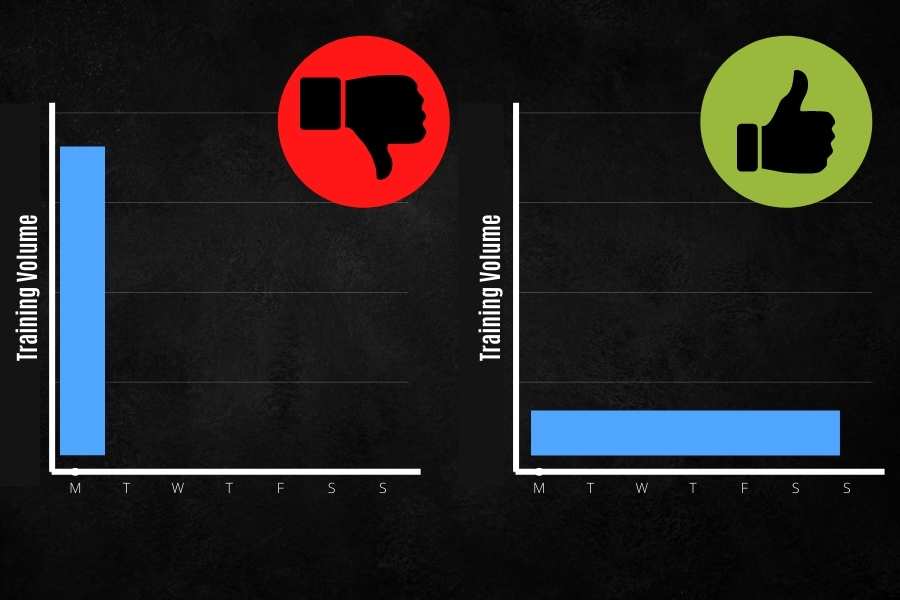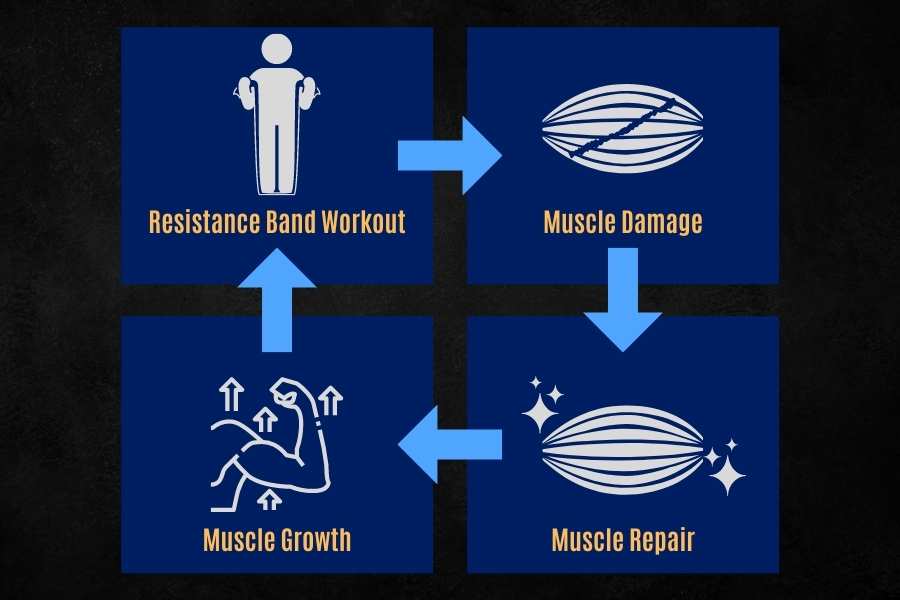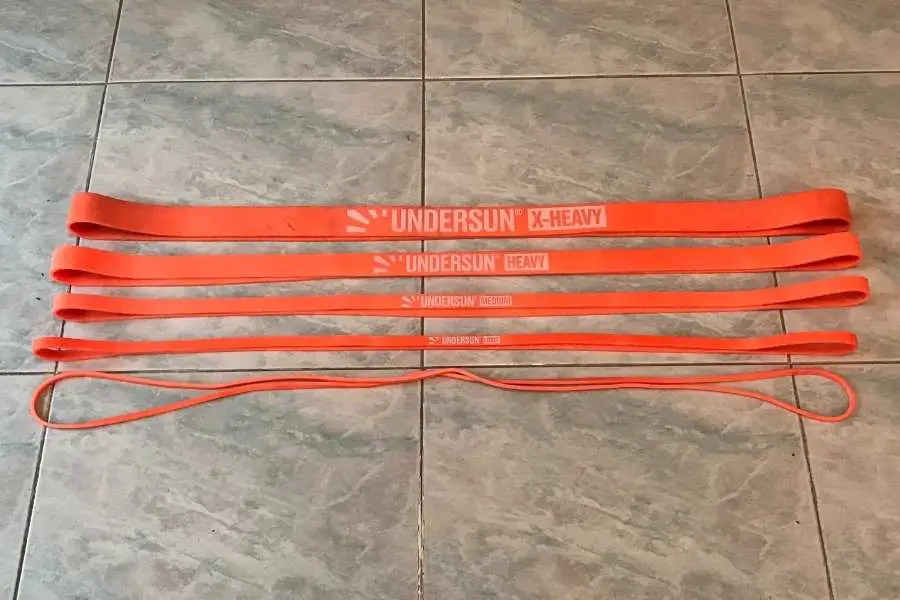If you’re new to resistance band workouts, it can be tempting to use them every day in the hopes of fast-tracking results. But hold up Hotshot. Using your bands too much can actually hinder your progression. This post explains exactly how often you should use your resistance bands!
Beginners should start by using resistance bands 2-3 days per week. After 1-2 years, they can progress up to 6 weekly workouts for maximum muscle growth. The most important point to consider is allowing each muscle at least 24-48 hours of rest between workouts.
I’ve been resistance band training for 5 years now.
During that time, I’ve experienced undertraining AND overtraining.
Below, I’ll explain why 2-6 days per week is the sweet spot for resistance band workouts!

- Why Beginners Should Use Resistance Bands 2-3 Times Per Week
- Why Intermediates Can Use Bands Up To 6 Times Per Week
- How Volume Influences How Often To Use Resistance Bands
- Why You Should Not Do Resistance Band Training Every Day
- Is It Possible To Overtrain With Resistance Bands?
- Recommended Resistance Bands For High-Frequency Workouts
- Conclusion
Why Beginners Should Use Resistance Bands 2-3 Times Per Week
Beginners should generally limit their use of resistance bands to 2 to 3 days per week. Each training day should be intense enough to fatigue the target muscles. Limiting resistance band workouts to a few times a week reduces the likelihood of overtraining and injury.
As someone who has just started working out, it can be tempting to train 7 days a week.
The more you train the faster you’ll see results right?
Yes, to a certain degree.
But after a certain threshold, increasing the number of training days can actually have a negative impact on your results.
That’s because of a phenomenon called overtraining.
This happens when you exert your muscles past the rate at which they can recover (remember your muscles break down and repair themselves after every intense workout).
To avoid overtraining, you can use a simple 3-day resistance band full-body training split like the one below:
| Day | Resistance Band Workout |
|---|---|
| Monday | Full-body |
| Tuesday | Rest |
| Wednesday | Full-body |
| Thursday | Rest |
| Friday | Full-body |
| Saturday | Rest |
| Sunday | Rest |
This is a much better alternative to using resistance bands every day of the week.
Here, you’re able to push your entire body on each workout, as well as give each muscle the 24-48 hours of rest it needs to fully recover in between workouts.
If you’ve planned your exercises well, each resistance band workout shouldn’t last longer than 1 hour.
Why Intermediates Can Use Bands Up To 6 Times Per Week
Intermediates can safely use resistance bands up to 6 times per week. That’s because their muscles are more conditioned compared to a beginner, and as such, are able to recover more quickly. However, it is still recommended to give each muscle 24-48 hours of rest between workouts.
After you’ve been regularly doing resistance band workouts for around 1-2 years, you should’ve progressed from a beginner to an intermediate.
By this point, your muscles should have adapted to the 3-day training split mentioned above.
Time to increase the intensity!
You can tell when you’re ready for this because workouts generally feel easier to complete and your muscles don’t feel as sore after a workout.
Now you can move onto a 6-day resistance band muscle group training split like the one below:
| Day | Resistance Band Workout |
|---|---|
| Monday | Chest and abs |
| Tuesday | Shoulders and back |
| Wednesday | Legs and arms |
| Thursday | Chest and abs |
| Friday | Shoulders and back |
| Saturday | Legs and arms |
| Sunday | Rest |
This is a better option than the 3-day training split because:
- You get more training volume. Each muscle sees more reps and sets per week compared to a full-body split. As a result, it’s a better workout to keep your body challenged.
- Each muscle still gets 24-48 hours of rest. This allows for optimum recovery.
Note- you don’t have to switch to a 6-day muscle group split if you don’t want to.
Your other option would be to stick to the 3-day full-body split and increase resistance band weight or add an extra training day to turn it into a 4-day full-body split.
But if you’re goal is to build muscle using resistance bands, then switching to the 6-day split is highly recommended.
How Volume Influences How Often To Use Resistance Bands
Now you may be asking:
“What’s the difference between the full-body and muscle-group split?”
And..
“Why should beginners do the former and intermediates switch to the latter?“
To understand why you need to understand the training volume principle.
Training volume– put simply- refers to the total amount of sets and reps you complete every week. It’s closely related to training frequency since more training days generally lead to more sets and reps being completed.

Generally speaking, the greater the volume the better the training benefits.
But this is only true up to a point.
Studies have also indicated that after a certain work threshold per workout has been reached, your muscles stop responding to any more training benefits.
In other words, there’s a law of diminishing returns and once your muscles are completely drained during a workout, they’ll stop responding to further training stimuli.
That’s why you can’t expect to cram all your weekly training volume into a single workout and expect the same results as someone who spreads their training volume over 2-3 days.

This is also why it’s important to choose the right number of reps and sets for each resistance band workout.
Additionally, you should also remember that your muscles need 24-48 hours of rest in between workouts for optimum recovery.
Therefore the objective of choosing the right resistance band training frequency is to balance your rest days with the required number of training days to satisfy your recommended training volume.
A beginner can get away with a 3-day full-body training split to see training results.
But an intermediate likely needs a 6-day muscle-group split to see the same training results because their muscles have adapted.
Both groups still need 24-48 hours of rest between workouts for optimal muscle recovery
If you’re interested, you can check out my other post which shares resistance band before and after results and exactly what you can expect to achieve when training frequency is optimized!
Why You Should Not Do Resistance Band Training Every Day
Generally speaking, it is not recommended to do resistance band training every day. Muscles grow and adapt on rest days after resistance band exercises have been completed. Therefore it is recommended to give each muscle a sufficient amount of time to recover in between workouts.
Here’s a simplified process for how muscles recover and rebuild themselves after a resistance band workout:

As you can see, it’s only after a resistance band workout that you’re muscles actually start rebuilding and repairing themselves.
And this is what causes the muscle to get bigger and tone up.
Therefore it doesn’t make sense to pummel your muscles with intense resistance band workouts every day.
You would just deny them the opportunity to recover.
Now, the exception to using resistance bands every day is if you were performing light workouts. You know, the kind where you’re doing bicep curls whilst watching TV or reading a book.
If your resistance band workout isn’t sufficient to meet the recommended training volume and completely fatigues your muscles, then you could train every day without consequences.
However, I much prefer to work out less frequently and more intensely to save time and get better training benefits.
You can check out my other post for more information on how to effectively use resistance bands at home.
Is It Possible To Overtrain With Resistance Bands?
It is completely possible to overtrain with resistance bands. Just like with any other type of resistance training, using bands too much can overexert the target muscles beyond their rate of recovery. When this happens, physical performance can become drastically reduced.
When resistance bands are used properly, they can be a great way to work out (just as effective as weights).
Just be careful not to overdo it.
As I mentioned before, it can be tempting to work out with your resistance bands every day and not realize you may be overtraining.
Here are some of the main symptoms associated with resistance band overtraining:
- Painfully sore muscles.
- Diminished muscular performance.
- Low strength levels.
- Reduced mood.
- Joint pain.
- Extreme fatigue.
The good news is that if you follow the recommended training frequency and do not use your resistance bands every day, it’s pretty difficult to enter the “overtraining” zone!
If you’re interested, you can go to my other article to find out exactly how resistance bands work and why they are as effective as weights.
Recommended Resistance Bands For High-Frequency Workouts
If you’re looking for a set of resistance bands to perform 3-6 day training splits, then you need something durable.
I use and recommend the Undersun resistance bands.

Having tried multiple brands in the past (all of which snapped on me), I can honestly say these are the hardest-wearing bands on the market in my opinion.
I love their 100% natural latex loop construction.
They can be stretched to 3x their length without even showing signs of weakness.
And best of all, they come with a lifetime warranty which I’ve yet to find in another competitor.
You may also be interested in my other article to find out why I feel resistance bands are worth the money!
Conclusion
I’ve explained how often you should use resistance bands.
A beginner should start with 2-3 full-body training days per week before progressing into a more intense routine.
As an intermediate, you can choose to do 4 full-body band workouts per week, or 6 muscle-group band workouts per week to build max muscle.
Ultimately, your training split can be flexible.
What’s most important is reaching a sufficient training volume for your fitness level and making sure each muscle gets at least 24-48 hours of full rest in between workouts!
That’s why it is not recommended to use resistance bands every day.
How often are you performing band workouts?
Feel free to send me a message if you have any questions! You can find my details on the “contact us” page.
You may also be interested in the downloadable Kalibre Blueprint PDF which details exactly how I gained 40lbs of lean muscle (it’s 100% free!). It details the exact exercises and nutrition (with printable worksheets) I used to go from skinny to ripped!
Thanks for reading guys!
Peace Out,
Kal
(Biochemistry BSc, Biomedical Sciences MSc, Ex-Skinny Guy)


